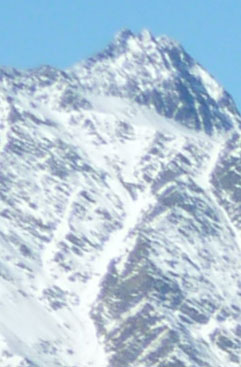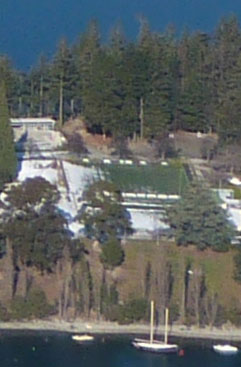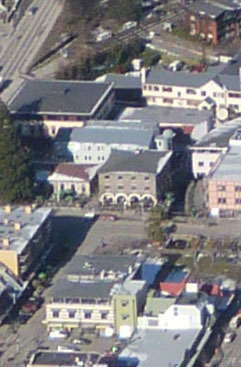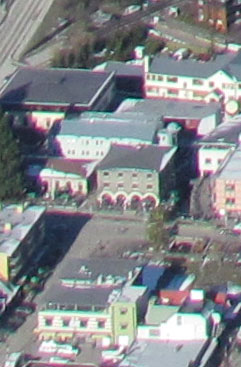Panasonic Lumix FZ47 / FZ48
-
-
Written by Gordon Laing
Quality
Panasonic Lumix DMC-FZ47 / FZ48 vs Lumix FZ40 / FZ45 vs Canon PowerShot SX30 IS image quality
|
Panasonic Lumix FZ47 / FZ48 |
Panasonic Lumix FZ45 / FZ40 |
Canon PowerShot SX30 IS | ||
 |  |  | ||
f4, 100 ISO |
f4, 80 ISO |
f4, 80 ISO | ||
 |  |  | ||
f4, 100 ISO |
f4, 80 ISO |
f4, 80 ISO | ||
 |  |  | ||
f4, 100 ISO |
f4, 80 ISO |
f4, 80 ISO | ||
 |  |  | ||
f4, 100 ISO |
f4, 80 ISO |
f4, 80 ISO |
Panasonic Lumix DMC-FZ47 / FZ48 vs Lumix FZ40 / FZ45 vs Canon PowerShot SX30 IS Noise
The image above was taken with the Panasonic Lumix FZ47 / FZ48 with the lens set to 7.4mm (42mm equivalent) and the aperture set to f3.2 in Program mode. The FZ47 / FZ48 was set to its minimum sensitivity of 100 ISO, where at f3.2 it metered an exposure of 0.3 seconds and generated a JPEG measuring 4.99MB. The crops below are taken from the area marked with the red rectangle and reproduced at 100%. To remind ourselves, the Lumix FZ47 / FZ48 may be the latest of the three cameras compared below, but employs the lowest resolution of 12 Megapixels, compared to 14 on its predecessor and Canon rival. This slightly lower resolution is responsible for the correspondingly larger area captured by the FZ47 / FZ48 in the crops below, but does it also allow it to enjoy lower noise levels? Let’s find out. With a lowest sensitivity of 100 ISO, the latest Lumix FZ47 / FZ48 actually misses out on a sample the first column, where the earlier Lumix FZ40 / FZ45 and Canon SX30 IS offer an 80 ISO setting. Both these models deliver roughly similar results in terms of detail, although worryingly both are also exhibiting clear noise textures even at double-digit sensitivities when examined closely at 100%. The Lumix FZ47 / FZ48 joins-in at 100 ISO, and while having two fewer Megapixels results in a slightly larger area in its crop, there’s arguably no less detail recorded than its rivals. Faint noise textures are also visible, but they’re a little more discreet than the Lumix FZ40 / FZ45 and Canon SX30 IS at this point. At 200 ISO noise levels increase on all three cameras, but the FZ47 / FZ48 enjoys a slightly crisper result than its predecessor and rival; the Canon SX30 IS is already suffering and becoming less defined than the other two. At 400 ISO, noticeable noise reduction has kicked-in on both Panasonics, but the FZ47 / FZ48 is a little cleaner. Meanwhile, the Canon SX30 IS has suddenly become very noisy with some digital artefacts. With the sensitivity doubled to 800 ISO, both Panasonics turn up their noise reduction, smearing out the speckles but also taking some fine detail with them. That said, pixel-peepers will probably prefer the FZ47 / FZ48 version. Once again the Canon is really suffering here and has fallen behind the Panasonics. At 1600 ISO neither Panasonic is looking great, but again the newer FZ47 / FZ48 enjoys a visible edge at 100%. Meanwhile, the Canon is fast turning into an impressionist painting. 1600 ISO marks the maximum sensitivity of each camera at their full resolutions, but each offers a scene preset with access to higher sensitivities at a reduced resolution. There’s no manual control over the sensitivity in these presets, but interestingly all three cameras automatically selected the same setting of 2000 ISO. Once again the FZ47 / FZ48 enjoys the edge over its predecessor which is suffering from some unnatural-looking artefacts. Panasonic’s decision to reduce the resolution of the FZ47 / FZ48 from its predecessor was in order to support faster continuous shooting and 1080i video, but as seen here it also enjoys the added benefit of slightly lower noise levels without compromising actual recorded detail. Pixel-peepers will see a small but visible edge over the FZ40 / FZ45, while both Panasonic’s continue to out-perform the earlier Canon SX30 IS at high sensitivities. Anyone hoping for a significant improvement in noise levels though will be disappointed to find the differences are quite subtle. Ultimately while the FZ47 / FZ48 indeed delivers better-looking images than its predecessor, you’ll have to look closely to spot the difference. That said, it’s a step in the right direction and I look forward to seeing Panasonic take further brave steps backwards in resolution to improve low-light performance. Then there’s Canon’s latest PowerShot SX40 HS which not only reduces the resolution from 14 to 12 Megapixels, but also switches from CCD to CMOS technology. Could we be witnessing the end of the Megapixel numbers game for prosumer super-zooms? I hope so, but make sure someone tells Sony… Now head over to my Panasonic Lumix FZ47 / FZ48 sample images to see more real-life shots in a variety of conditions.
|
























